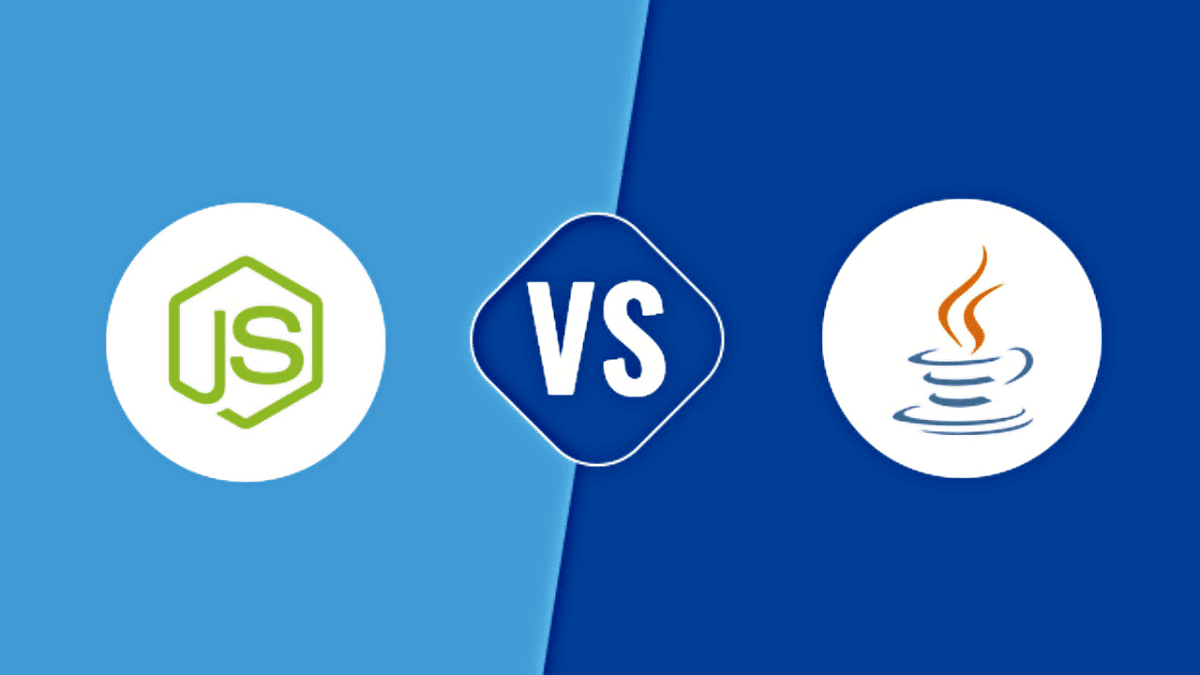Selecting the appropriate backend technology is essential whether you’re developing a large-scale enterprise application or a straightforward CRUD app. Java and Node.js are two of the most widely used platforms for backend development nowadays.
However, how can you determine which one best meets your needs?
To assist you in choosing a backend tech stack, we’ll examine Node.js and Java in this in-depth guide across 11 distinct criteria.
By the end, you’ll be able to choose the best techstack for your next project by having a clear understanding of the advantages and disadvantages of both platforms. Now let’s get started!
What is Node.js?
A JavaScript runtime environment called Node.js enables programmers to execute JavaScript server-side. Its lightweight and efficient I/O model is event-driven and non-blocking.
Several essential Node.js features are:
- Uses JavaScript for server-side scripting
- Extremely fast due to its non-blocking, event-driven model
- Packaged with npm, the largest ecosystem of open source libraries
- Perfect for building scalable, real-time web applications
- Popular for developing microservices architectures
Modern web applications are increasingly being built with Node.js because of its scalability, speed, and wide library support. Node.js is widely used by businesses like Netflix, Uber, Paypal, and eBay in their tech stacks.
What is Java?
Since the 1990s, Java has been a potent general-purpose programming language. Running on a Java Virtual Machine (JVM), it is an object-oriented language that has been compiled.
Several essential Java features are:
- Statically typed and strictly object-oriented
- Platform independent – “write once, run anywhere”
- Huge ecosystem of open source libraries
- Very mature technology with extensive documentation
- Heavily used by large enterprises and for mission-critical systems
Java is renowned for its dependability, security, and strength. Numerous websites, apps, and systems are powered by it. For their backend requirements, major corporations like Amazon, Netflix, Google, LinkedIn, and others rely on Java.
Comprehensive Comparison Java vs Node.js
Node.js provides an innovative solution. Unlike traditional approaches, Node.js’s JavaScript foundation enables developers to use the same comfortable syntax for client-side and server-side tasks, resulting in a much faster and more agile workflow.
Not only that, but Node.js is more scalable than other technologies because of its event loop mechanism, which enables non-blocking server responses. And to top it all off, Node.js is a clear winner in terms of usability because developers adore it for being lightweight.
Strong memory management and concurrent accumulators, which improve application performance and dependability, are two more noteworthy characteristics of Java.
The lives of developers are made much easier by the abundance of libraries available in both Java and Node.js.

1. Stability
Java is very stable and sophisticated, having been around since the mid-1990s. Over the years, the Java platform has seen significant advancements, and Java code created 20 years ago is still functional today. For mission-critical applications, enterprises usually select Java due to its stability and almost zero downtime.
Conversely, Node.js is a relatively new technology, having launched in 2009. There are still changes to the core API that affect backward compatibility. Nonetheless, there are regular release cycles that include bug fixes and new enhancements. Node.js has grown significantly more reliable over time, and businesses are now comfortable using it for production workloads.
2. Scability
A strong tool for creating applications that are incredibly scalable is Node.js. It is perfect for handling high traffic because of its event-oriented model and non-blocking input and output system, which allow it to handle multiple concurrent requests.
Moreover, the event-loop mechanism of Node.js offers scalability and efficiency by enabling the server to efficiently handle a high volume of requests. To further enhance scalability and efficiency, Node.js leverages a distributed system for various kinds of services.
Java’s superior performance and scalability make it a popular choice for developing enterprise applications. However, developers need to follow best practices when adding computational resources like RAM and CPUs if they want to realize its full potential.
Java handles the single point of failure problem in addition to providing a range of scaling options, such as vertical and horizontal scaling. Java’s architecture can also meet all of your needs.
3. Documentation
A valuable tool for learning new languages and comprehending their potential are documentation pages. An extensive overview of the language, including guides, ES6 features, and API reference documentation, can be found on the Node.js documentation page.
This gives developers a thorough grasp of both the popular and specialized features of Node.js. Comparably, the documentation for Java is an extensive database containing all language-related information, which makes it an invaluable tool for developers of all experience levels.
4. Community
The community support of Node.js and Java is one important area of difference. Over 6.3 million websites in the US use Node.js alone, according to enterprise apps today.
Tech behemoths like Facebook, Google, and Amazon have also made substantial contributions to Node.js, which has helped it acquire credibility. Java, on the other hand, has a more seasoned user base and a longer history of support.
Similar to Node.js, Java boasts a robust community that facilitates the resolution of intricate problems. This sizable community fosters constant innovation, frequent updates, and speedy bug fixes. Java is currently used as the backend for more than 44K websites.
Java, one of the top three programming languages, has a thriving software developer community supported by sites like the Oracle-Java Forum, StackOverflow, Coderanch, and Java World.
5. Talent Pool
According to Statista, there will be more than 28.7 million developers globally by 2024. These figures are expected to rise in the years to come, according to researchers.

Node.js is ranked first in the “most wanted” category and second in the “most loved” category for frameworks, libraries, and tools. Java does well in the survey as well.
6. User Friendly
Given that all you need to know is JavaScript, Node.js has an extremely low learning curve. Both the frontend and the backend utilize the same language and paradigm. JS knowledge enables you to create fullstack apps rapidly. Basic Node.js constructs from frontend JavaScript, such as functions, objects, and arrays, also function similarly on the server.
Java, however, has a more difficult learning curve. The syntax is statically typed, verbose, and requires additional code. You also need to consider classes, interfaces, access modifiers, and other related concepts. Although the syntax of JVM languages like Kotlin and Groovy has improved, base Java is still difficult for novices to understand.
7. Performance
Developers can find it easier to code with the vast libraries and reusable components created by the community in both Java and Node.js. In this comparison, Node.js has the slight advantage.
Jeff Harrell, a former PayPal Chief Architect and Director of Engineering, claims that Node.js apps require 40% fewer files and 33% fewer lines of code. Consequently, Node.js app development takes less time overall.
It is important to remember that the length of the development period can change based on the kind of project, the size of the team, and the language skills of the members.
In contrast, Java code tends to be verbose and requires a lot of boilerplate code, even for basic functions like file I/O. Development may be slowed down as a result in comparison to scripting languages. But Java’s robust typing and conventions also help to prevent some bug classes.
8. Installation
It’s quite simple to install Node.js. Node only needs to be downloaded in order to get started. With excellent cross-platform support, Node.js runs on Windows, Linux, MacOS, and really any other system. All you need is a lightweight text editor; an enormous IDE is not necessary.
Installing Java is more difficult. Installing the JDK, an application server such as Tomcat, and possibly an IDE such as Eclipse or NetBeans are required. Additionally, there are several JVM languages available, such as Scala and Groovy, which can be confusing for novices. Node.js tools are lightweight, while Java tools are bulky.
9. Database Support
While NodeJS can be used with many relational and NoSQL databases, it works best with NoSQL databases such as MongoDB. This is because MongoDB makes it possible to store data as JSON objects, which improves accessibility for JavaScript-based backends like NodeJS.
Furthermore, a dedicated object data-modeling library built for Node.js was created expressly to work with MongoDB. Additionally, it increases developer productivity by improving the readability and flexibility of the code.
Many databases run on top of Java, and applications that access data use Java Database Connectivity, a standard database connectivity protocol. A few of the frequently used databases are PostgreSQL, SQLite, and MySQL.
Developers and programmers use built-in Java databases to create basic projects. Furthermore, relational databases’ issues can be resolved by JDBC-enabled databases.
10. Development Cost
Node.js developers make between $89K and 143K annually, while Java programmers in the US typically earn between $92K and $135K, according to Glassdoor estimates.
In contrast, the annual salary of a Senior Java developer in India is between $5,000 and $6,000 USD. This indicates that Java development is typically less expensive in the Indian market.
However, costs can differ significantly when using independent contractors or outsourcing development. Various factors, including project complexity, management style, and potential drawbacks, influence cost estimates, making a precise estimate challenging to achieve. Obtain quotes from several Java and Node.JS development companies to have a more precise idea of the costs.
So, Node.js or Java?
When should you choose Node.js?
- Creating web applications for content streaming
- Node.js development services
- Building effective one-page applications
- Constructing web apps with effective data processing features
- Creating multi-user, real-time web applications
- Making applications for games that run in browsers.
When should you choose Java?
- Custom Java app development
- Building scalable applications
- Creating eCommerce applications
- Developing Big Data applications
- Developing applications for cryptocurrencies with advanced security features
Conclusion
In conclusion, each of Java and Node.js has a unique set of benefits and drawbacks, and it’s critical to comprehend them in order to choose wisely for your upcoming project. Node.js typically performs faster, but Java is better at stability and security. Developer resources and robust communities are available for both technologies.
Java is best suited for web applications, scientific applications, trading applications, and e-commerce, while Node.js is frequently used for real-time applications, streaming, big data projects, and e-commerce. One option is to work with the top Java development company.
Speak with specialists who are knowledgeable about both technologies and your particular niche if you are confused about which one to use for your project.

Javier is Content Specialist and also .NET developer. He writes helpful guides and articles, assist with other marketing and .NET community work



